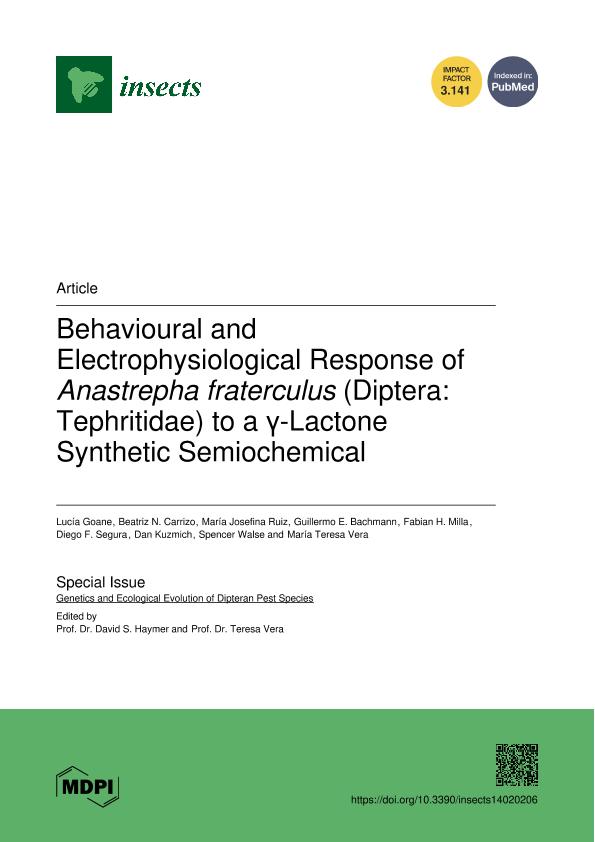Mostrar el registro sencillo del ítem
dc.contributor.author
Goane, Lucía

dc.contributor.author
Carrizo, Beatriz Noemí

dc.contributor.author
Ruiz, María Josefina

dc.contributor.author
Bachmann, Guillermo Enrique

dc.contributor.author
Milla, Fabian Horacio

dc.contributor.author
Segura, Diego Fernando

dc.contributor.author
Kuzmich, Dan
dc.contributor.author
Walse, Spencer
dc.contributor.author
Vera, María Teresa

dc.date.available
2023-10-17T13:38:48Z
dc.date.issued
2023-02
dc.identifier.citation
Goane, Lucía; Carrizo, Beatriz Noemí; Ruiz, María Josefina; Bachmann, Guillermo Enrique; Milla, Fabian Horacio; et al.; Behavioural and Electrophysiological Response of Anastrepha fraterculus (Diptera: Tephritidae) to a γ-Lactone Synthetic Semiochemical; MDPI; Insects; 14; 2; 2-2023; 1-14
dc.identifier.issn
2075-4450
dc.identifier.uri
http://hdl.handle.net/11336/215134
dc.description.abstract
Attractants are a powerful tool for pest management. The lack of specific attractants for the South American fruit fly, Anastrepha fraterculus, a complex of cryptic species of great economic importance in South America, makes it difficult to monitor the pest in the field. The γ-lactone male sex and aggregation pheromones of several Anastrepha species, naturally released in a 7:3 epianastrephin to anastrephin ratio, and a structurally related naturally occurring γ-lactone ((±)-trans-tetrahydroactinidiolide) with gem-dimethyl groups (dimethyl) at C(4), were evaluated as potential attractants of this species. Different age and mating conditions of A. fraterculus males and females were evaluated during electroantennography (EAG) and field cage experiments in which polymeric lures were deployed to contain 100 mg of attractant. Epianastrephin and dimethyl were EAG+ for all fly conditions, with epianastrephin eliciting the highest response for both sexes and immature flies showing greater responsiveness than mature flies. In the field cage experiments, immature flies were only attracted to leks; virgin females were attracted to leks, dimethyl, and both epianastrephin-anastrephin formulations (95 and 70 wt.% epianastrephin); mature-mated males were attracted to leks, dimethyl and 70 wt.% epianastrephin; and mature-mated females were only attracted to leks. Our bioassays showed a promising performance of the analog dimethyl since it elicited the same response as epianastrephin, requires fewer steps to synthesize, and contains one less chiral center than the natural pheromones. The attraction to leks was recorded for all mating conditions and ages of flies and suggests that air-borne volatiles of calling males contain cues that could act as sensory traps. The addition of any of these compounds in the synthetic attractants may result in a greater attraction and thus deserves further evaluation. Dose-response experiments will provide additional information to move a step forward and validate the results obtained in open-field conditions.
dc.format
application/pdf
dc.language.iso
eng
dc.publisher
MDPI
dc.rights
info:eu-repo/semantics/openAccess
dc.rights.uri
https://creativecommons.org/licenses/by/2.5/ar/
dc.subject
(±)-ANASTREPHIN
dc.subject
(±)-EPIANASTREPHIN
dc.subject
(±)-TRANS-TETRAHYDROACTINIDIOLIDE
dc.subject
DIMETHYL
dc.subject
FIELD CAGE EXPERIMENTS
dc.subject
IPM
dc.subject
PHYSIOLOGICAL STATUS
dc.subject
SPECIES-SPECIFIC ATTRACTANTS
dc.subject.classification
Otras Ciencias Biológicas

dc.subject.classification
Ciencias Biológicas

dc.subject.classification
CIENCIAS NATURALES Y EXACTAS

dc.title
Behavioural and Electrophysiological Response of Anastrepha fraterculus (Diptera: Tephritidae) to a γ-Lactone Synthetic Semiochemical
dc.type
info:eu-repo/semantics/article
dc.type
info:ar-repo/semantics/artículo
dc.type
info:eu-repo/semantics/publishedVersion
dc.date.updated
2023-10-12T14:55:27Z
dc.journal.volume
14
dc.journal.number
2
dc.journal.pagination
1-14
dc.journal.pais
Suiza

dc.description.fil
Fil: Goane, Lucía. Consejo Nacional de Investigaciones Científicas y Técnicas. Centro Científico Tecnológico Conicet - Tucumán; Argentina. Universidad Nacional de Tucumán. Facultad de Agronomía y Zootecnia; Argentina
dc.description.fil
Fil: Carrizo, Beatriz Noemí. Instituto Nacional de Tecnología Agropecuaria. Centro Regional Tucuman-Santiago del Estero. Estación Experimental Agropecuaria Famaillá; Argentina
dc.description.fil
Fil: Ruiz, María Josefina. Consejo Nacional de Investigaciones Científicas y Técnicas. Centro Científico Tecnológico Conicet - Tucumán; Argentina. Universidad Nacional de Tucumán. Facultad de Agronomía y Zootecnia; Argentina
dc.description.fil
Fil: Bachmann, Guillermo Enrique. Instituto Nacional de Tecnología Agropecuaria. Centro de Investigación en Ciencias Veterinarias y Agronómicas. Instituto de Agrobiotecnología y Biología Molecular. Consejo Nacional de Investigaciones Científicas y Técnicas. Oficina de Coordinación Administrativa Parque Centenario. Instituto de Agrobiotecnología y Biología Molecular; Argentina
dc.description.fil
Fil: Milla, Fabian Horacio. Instituto Nacional de Tecnología Agropecuaria. Centro de Investigación en Ciencias Veterinarias y Agronómicas. Instituto de Agrobiotecnología y Biología Molecular. Consejo Nacional de Investigaciones Científicas y Técnicas. Oficina de Coordinación Administrativa Parque Centenario. Instituto de Agrobiotecnología y Biología Molecular; Argentina
dc.description.fil
Fil: Segura, Diego Fernando. Instituto Nacional de Tecnología Agropecuaria. Centro de Investigación en Ciencias Veterinarias y Agronómicas. Instituto de Agrobiotecnología y Biología Molecular. Consejo Nacional de Investigaciones Científicas y Técnicas. Oficina de Coordinación Administrativa Parque Centenario. Instituto de Agrobiotecnología y Biología Molecular; Argentina
dc.description.fil
Fil: Kuzmich, Dan. United States Department of Agriculture. Agriculture Research Service; Estados Unidos
dc.description.fil
Fil: Walse, Spencer. United States Department of Agriculture. Agriculture Research Service; Estados Unidos
dc.description.fil
Fil: Vera, María Teresa. Consejo Nacional de Investigaciones Científicas y Técnicas. Centro Científico Tecnológico Conicet - Tucumán; Argentina. Universidad Nacional de Tucumán. Facultad de Agronomía y Zootecnia; Argentina
dc.journal.title
Insects
dc.relation.alternativeid
info:eu-repo/semantics/altIdentifier/url/https://www.mdpi.com/2075-4450/14/2/206
dc.relation.alternativeid
info:eu-repo/semantics/altIdentifier/doi/http://dx.doi.org/10.3390/insects14020206
Archivos asociados
